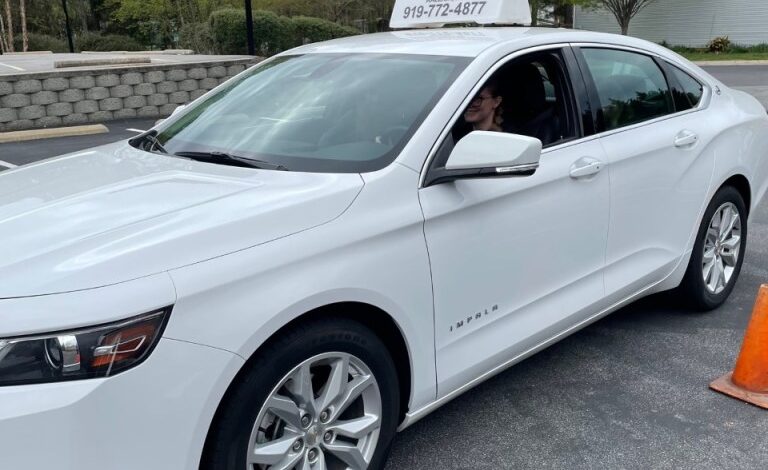NC House bill would further shorten practice period for teen drivers


By Jennifer Fernandez
When North Carolina implemented a year of practice as part of a new graduated driver’s licensing for 16- and 17-year-olds in the 1990s, the state saw an almost immediate plunge in fatal crashes for those kids.
But during the pandemic, lawmakers temporarily shortened the time required for teens to drive with supervision from from 12 months to six. In 2023, amid constituent complaints about delays in getting teens their final licenses, they decided not to restore the 12-month training period, opting for nine months instead.
Since then, the crash rate for young drivers in North Carolina has risen 13 percent, new data shows.
Now legislators are looking to further reduce the period of time teens are required to have supervision while driving. Their proposal would require only 60 hours behind the wheel before drivers who are at least 16 years old could move to the second level of the state’s graduated driver’s license system.
The House Transportation Committee is expected to resume discussion of House Bill 584 at 10 a.m. today, April 16.
The licensing system, enacted in 1997, is credited with dropping fatal and serious injury crashes among the state’s 16-year-old drivers by 46 percent. The lower crash rates held steady until 2021, during the pandemic, when the lawmakers reduced that required practice period, researchers with the Highway Safety Research Center at UNC Chapel Hill told NC Health News.
Rep. David Willis (R-Marvin), the primary sponsor of HB584, told legislators last week that parents have been asking for changes because of long waits to get into Division of Motor Vehicles offices. The DMV struggled with wait times before and during the pandemic — and staffing shortages on top of more people moving to the state, combined with a looming deadline next month for people to obtain a Real ID — have added to the workload.
A search of the DMV site on Tuesday showed the Fuquay-Varina DMV office as the only one statewide with available appointments for any of the three stages of the graduated driver’s license. Afternoon wait times that same day at driver’s license offices across the state ranged from no waiting at the Craven County building in Havelock in the eastern part of the state, to nearly three and a half hours in Mocksville in the Central Piedmont, according to the DMV’s wait-time tracker.
Those long waits should not be used as the impetus to reduce practice time and thus weaken the young driver’s licensing system, said Robert Foss, who has studied teen driving safety issues for decades. Foss, director emeritus of the Center for the Study of Young Drivers at the Highway Safety Research Center, helped develop graduated driver’s licensing.
Foss said the state’s licensing system, which has been viewed as the gold standard in the country for decades, “guarantees that young beginning drivers are reasonably competent when they start … to drive on their own.”
The key, he said, is the varied experiences young drivers get over a long period of time. The state originally required drivers to have a learner’s permit for 12 months. During that time, they were more likely to experience driving in spring rains or winter snow, and through bright summer sun or gusty fall days.
“Unfortunately, we’ve already seen that damaged by the legislature a couple of years ago when they cut [the driving period] back over all the evidence available,” Foss said. “And now we’ve seen the result, which is 16-year-old crashes — having gone down for close to 30 years — have now started back up.”
Proposed changes
Three changes to the graduated driver’s license system are being considered.
- Drop the requirement that teens have a learner’s permit for at least nine months.
- Eliminate the driving eligibility certificate requirement. The school form must be filled out to show the student is enrolled in school and making progress toward graduation.
- Allow teen drivers to get a full provisional license online instead of in person and have the license mailed to them.
Foss said the driving eligibility certificate requirement was initially intended to keep students in school. But, he said it placed “a massive burden” on school systems as it didn’t come with any funding to enact it.
Willis agreed, arguing it no longer served a purpose.
“The DMV is willing to let that go. The schools don’t want to have to deal with that hassle anymore,” he said.
Moving the provisional license process online would “avoid some of the appointment headaches that we have right now for an appointment that’s really unnecessary,” Willis said. At that stage, drivers must submit a log showing they have driven at least 12 hours, half of them at night.
“We’ve asked that within this bill that the DOT look at ways of being able to do that online,” he said.
That appears to be in line with the DMV’s move to provide more online services, DMV communications manager Marty Homan said.
If the General Assembly approves the bill, the changes would become effective Oct. 1. They would apply to permit or provisional license applications submitted on or after that date.
Graduated license system
North Carolina’s graduated license system for young drivers has three parts.
Level 1
- Limited learner’s permit for teens who are at least 15 years old but under age 18.
- Learners must pass a written test and driver’s education and have a driving eligibility certificate, a high school diploma or its equivalent.
- Driving at this stage must always be under the supervision of a licensed driver.
Level 2
- Limited provisional license for teens who are at least 16 years old but under age 18.
- Drivers must have logged a minimum of 60 hours of driving.
- The driver must have had a learner’s permit for at least nine months before applying for this stage.
- They have to have a driving eligibility certificate, a high school diploma or its equivalent.
- Drivers are mostly on their own at this stage, but must have a supervising driver after 9 p.m. unless they are driving to or from work, or for certain volunteer activities.
Level 3
- Full provisional license for teens who are at least 16 years old but under age 18.
- Drivers must have had a limited provisional license for at least six months and submit a driving log showing a minimum of 12 hours, including at least six hours at night.
- They also must have a driving eligibility certificate, a high school diploma or its equivalent.
Is 60 hours enough?
The biggest change proposed in HB584 would eliminate the nine-month period that a learner’s permit must be held before the driver can apply for the second stage of the licensing process.
Willis called it a “waiting period.”
Caroline Mozingo, co-director of the Highway Safety Research Center, instead described it as “an imperative practice period for … new drivers.”
At last week’s committee meeting, Rep. Zach Hawkins (D-Durham) said he is not in favor of the bill, particularly the change in the practice period. He asked Willis if he would be willing to amend the bill to reduce the nine months to six months “so there is more time for a driver to get more experience on the roads.”
Willis said he would be amenable to that. He added that the 60-hour requirement would probably take several months for most students anyway.
Tom Vitaglione, a longtime advocate for children’s health issues in the state, told NC Health News there’s no evidence the 60 hours “actually makes a difference.”
“Legislators are thinking, ‘Oh, I can count on that. That’s going to work,’” he said. “But once again, they’ve not taken the time to look at the science.”
Foss said that if the 60-hour requirement was all that was needed to cut down on crashes, there would have been no change when the practice period dropped from 12 months to six months.
Instead, with fewer months of supervised experience, the crash rate for 16-year-old drivers increased by 13 percent, according to preliminary data. And early data for 2024 shows crash rates at that same higher level, Foss said.
Variety matters
There’s no way to mandate what is needed as far as the exact type of practice, Foss said. That’s why more time on the road is important.
“These kids need to drive on every kind of road that’s out there, at all times of the day, at all times of the year, and they need to do it a lot,” he said. “Going out and driving on an interstate a few times isn’t enough. Going out and driving on a rural road for a couple hours on a Sunday isn’t enough.”
“What you want,” Foss continued, “is for these kids to run into every possible thing that they can … while you’re sitting there with them so you can help.”
The crash data is preliminary so it could change, but while Foss thinks it’s highly unlikely the crash rate will drop as data is examined further, there’s a good chance that it will increase.
“Everything done to weaken the system means everyone driving in North Carolina is at greater risk … by putting teens out there that aren’t as well trained as they could be — and should be,” he said.
DMV wait times
Several factors are contributing to what can be long wait times at driver’s license offices, said DMV spokesman Marty Homan.
Hundreds of people a day are moving to North Carolina, and their first transaction with the DMV has to be in person, he said.
Last month alone, there were 185,000 in-person transactions, he said. Of those, 82,000 were to obtain a Real ID. The new driver’s licenses and state identification cards come with enhanced security measures and require proof of identity such as a certified birth certificate. The new identification document will be required to access certain federal facilities and to board planes starting May 7.
All three stages of the state’s graduated driver’s license require an in-person visit. Last month, the DMV logged 17,786 visits for young drivers in the program, according to data Homan shared with NC Health News.
Meanwhile, staffing at DMV offices hasn’t kept up with the growing need, Homan said. The agency is working to address those needs by asking legislators to add more offices and staff, and expanding office hours, he said. And now, more offices are open early in the morning and more have Saturday hours. There are also more summer hours in many locations.
“Those offices really hum, because every workstation is filled with an examiner and extras to do road tests,” he said.
KEEP UP WITH THE LATEST
The post NC House bill would further shorten practice period for teen drivers appeared first on North Carolina Health News.






